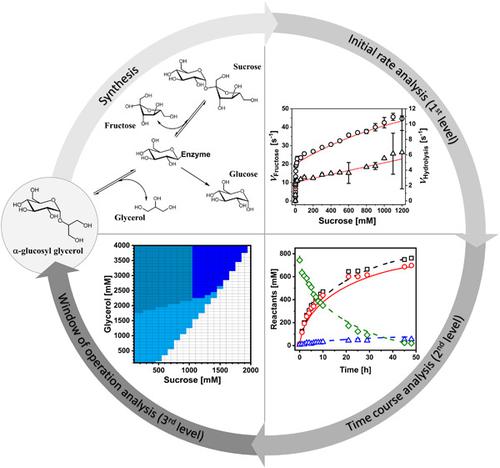当前位置:
X-MOL 学术
›
Biotechnol. Bioeng.
›
论文详情
Our official English website, www.x-mol.net, welcomes your
feedback! (Note: you will need to create a separate account there.)
Three-level hybrid modeling for systematic optimization of biocatalytic synthesis: α-glucosyl glycerol production by enzymatic trans-glycosylation from sucrose
Biotechnology and Bioengineering ( IF 3.5 ) Pub Date : 2021-07-07 , DOI: 10.1002/bit.27878 Alexander Sigg 1 , Mario Klimacek 1 , Bernd Nidetzky 1, 2
Biotechnology and Bioengineering ( IF 3.5 ) Pub Date : 2021-07-07 , DOI: 10.1002/bit.27878 Alexander Sigg 1 , Mario Klimacek 1 , Bernd Nidetzky 1, 2
Affiliation

|
Mechanism-based kinetic models are rigorous tools to analyze enzymatic reactions, but their extension to actual conditions of the biocatalytic synthesis can be difficult. Here, we demonstrate (mechanistic-empirical) hybrid modeling for systematic optimization of the sucrose phosphorylase-catalyzed glycosylation of glycerol from sucrose, to synthesize the cosmetic ingredient α-glucosyl glycerol (GG). The empirical model part was developed to capture nonspecific effects of high sucrose concentrations (up to 1.5 M) on microscopic steps of the enzymatic trans-glycosylation mechanism. Based on verified predictions of the enzyme performance under initial rate conditions (Level 1), the hybrid model was expanded by microscopic terms of the reverse reaction to account for the full-time course of GG synthesis (Level 2). Lastly (Level 3), the application of the hybrid model for comprehensive window-of-operation analysis and constrained optimization of the GG production (~250 g/L) was demonstrated. Using two candidate sucrose phosphorylases (from Leuconostoc mesenteroides and Bifidobacterium adolescentis), we reveal the hybrid model as a powerful tool of “process decision making” to guide rational selection of the best-suited enzyme catalyst. Our study exemplifies a closing of the gap between enzyme kinetic models considered for mechanistic research and applicable in technologically relevant reaction conditions; and it highlights the important benefit thus realizable for biocatalytic process development.
中文翻译:

用于系统优化生物催化合成的三级混合建模:蔗糖酶促反式糖基化生产α-葡萄糖基甘油
基于机理的动力学模型是分析酶促反应的严格工具,但将其扩展到生物催化合成的实际条件可能很困难。在这里,我们展示了(机械-经验)混合建模,用于系统优化蔗糖磷酸化酶催化的蔗糖甘油糖基化,以合成化妆品成分 α-葡萄糖基甘油 (GG)。开发经验模型部分是为了捕捉高蔗糖浓度(高达 1.5 M)对酶促反式糖基化机制的微观步骤的非特异性影响。基于对初始速率条件下酶性能的验证预测(第 1 级),混合模型通过逆反应的微观术语进行扩展,以解释 GG 合成的全时过程(第 2 级)。最后(第 3 级),展示了混合模型在 GG 生产(~250 g/L)的综合操作窗口分析和约束优化中的应用。使用两种候选蔗糖磷酸化酶(来自肠系膜明串珠菌和青春双歧杆菌),我们将混合模型揭示为“过程决策”的有力工具,以指导合理选择最合适的酶催化剂。我们的研究证明了酶动力学模型之间的差距缩小,这些模型被考虑用于机械研究并适用于技术相关的反应条件;它强调了生物催化工艺开发的重要好处。
更新日期:2021-09-12
中文翻译:

用于系统优化生物催化合成的三级混合建模:蔗糖酶促反式糖基化生产α-葡萄糖基甘油
基于机理的动力学模型是分析酶促反应的严格工具,但将其扩展到生物催化合成的实际条件可能很困难。在这里,我们展示了(机械-经验)混合建模,用于系统优化蔗糖磷酸化酶催化的蔗糖甘油糖基化,以合成化妆品成分 α-葡萄糖基甘油 (GG)。开发经验模型部分是为了捕捉高蔗糖浓度(高达 1.5 M)对酶促反式糖基化机制的微观步骤的非特异性影响。基于对初始速率条件下酶性能的验证预测(第 1 级),混合模型通过逆反应的微观术语进行扩展,以解释 GG 合成的全时过程(第 2 级)。最后(第 3 级),展示了混合模型在 GG 生产(~250 g/L)的综合操作窗口分析和约束优化中的应用。使用两种候选蔗糖磷酸化酶(来自肠系膜明串珠菌和青春双歧杆菌),我们将混合模型揭示为“过程决策”的有力工具,以指导合理选择最合适的酶催化剂。我们的研究证明了酶动力学模型之间的差距缩小,这些模型被考虑用于机械研究并适用于技术相关的反应条件;它强调了生物催化工艺开发的重要好处。











































 京公网安备 11010802027423号
京公网安备 11010802027423号